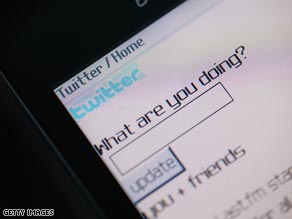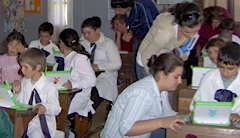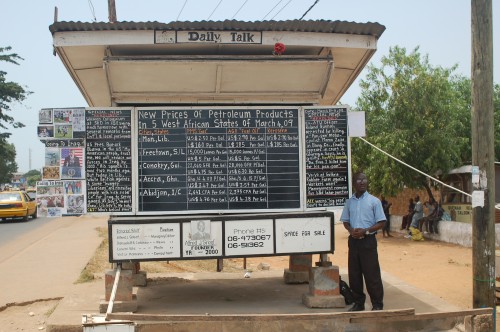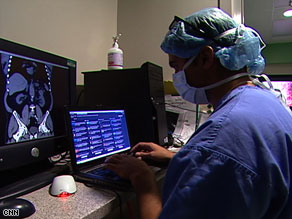Again, just watch!
Saturday, May 9, 2009
Anthropology of You Tube
It's simple: just watch!
Labels:
classroom 2.0,
collaboration,
tools,
web2.0,
YouTube
Friday, April 24, 2009
A Different Kind of Distance Learning (and Teaching)
I recently saw this piece in Ode Magazine that talked about people from Guatemala providing online language instruction via the internet.
Twice a week, Margo Griffin, who lives in Denver, Colorado, has a one-on-one Spanish lesson with her teacher, Mayra Juárez, who lives miles and miles away, in Antigua, Guatemala. Both attend from the comfort of their homes via the Internet, a webcam and an innovative socially responsible business called Speak Shop.
Labels:
classroom 2.0,
distance learning,
distance teaching,
learning,
online,
teaching,
web2.0
Telekinetic Twittering
Here on CNN.com is a very cool article about people being able to Twitter by just thinking.
Wilson, a doctoral student in biomedical engineering, was confirming an announcement he had made two weeks earlier -- his lab had developed a way to post messages on Twitter using electrical impulses generated by thought.
Tuesday, April 21, 2009
Testing Out SlideRocket
I have been playing with a new Web 2.0 presentation tool called SlideRocket. It is pretty slick and pretty easy to use.
Here is a presentation I put together.
Here is a presentation I put together.
Labels:
classroom 2.0,
digital storytelling,
personal,
presentations,
tools,
web2.0
Saturday, April 11, 2009
Digital Storytelling
This morning, I found this amazing presentation about using Digital Storytelling with students via the Fireside Learning Community.
Check it out.

Digital Storytelling Presentation
Check it out.

Digital Storytelling Presentation
Wednesday, April 8, 2009
Little Bloggers
The blog Rising Voices recently posted a story about children in Uruguay being trained to blog using their XO Laptops.
Pablo Flores of Ceibal, the governmental organization in charge of distributing OLPC laptops in Uruguay, will organize a series of workshops which will gather national and international bloggers with the young laptop-toting students to show them how to set up a blog and take advantage of other social media tools.
So now, what happens when those students have a global voice? What do they say and to whom? And then what happens?
Labels:
classroom 2.0,
olpc,
student blogging,
uruguay,
web2.0,
xolaptop
Monday, April 6, 2009
Extreme Collaboration
The New York Times has a nice piece today about a group of elementary school students who played chess with an astronaut on the International Space Station.
After their game, and after he returned to Earth, they all met to talk about the experience.
Now, that's extreme collaboration via technology!
Sunday, April 5, 2009
Analog Blogging
It is now so important to be connected via wired and wireless devices. We can, for example, blog from our desktops, laptops, cell phones, Blackberry devices. In the office, at home, in libraries, in coffee shots, on the subway, etc.
And this is assuming that blogging is fast enough for our communication needs.
But, what if you were in a non-connected place and wanted to comment on the world around you. How about blogging on a blackboard.
Here is a really interesting story of just such a project by a man in Monrovia. Check it out.
Labels:
blogging,
cool stuff,
social networks,
tools,
web2.0
The Odyssey on Twitter
Sunday, March 1, 2009
Cool Science Classroom
The Scientist recently reported about a high school science teacher who is doing incredible things with Web 2.0 tools, especially blogs and podcasts, with her biology students.
Check out the article here.
Check out this science teacher's work here.
Check out the article here.
Check out this science teacher's work here.
Labels:
classroom 2.0,
edtech,
edublogs,
education,
education 2.0,
web2.0
Saturday, February 28, 2009
Tweeting Surgery
CNN.com recently posted this story of a surgeon who Twittered during a complex surgery.
It make me wonder how I might use Twitter as a teacher.
Any ideas?
Labels:
classroom 2.0,
social networks,
tools,
Twitter,
web2.0
Tuesday, February 17, 2009
You are Here?
An article in today's New York Times talks about the extensive use of maps as tools in various cell phone/SmartPhone applications:
It has been 25 years since the desktop, with its files and folders, was introduced as a way to think about what went on inside a personal computer. The World Wide Web brought other ways of imagining the flow of data. With the dominance of the cellphone, a new metaphor is emerging for how we organize, find and use information. New in one sense, that is. It is also as ancient as humanity itself. That metaphor is the map.
The piece goes on to connect maps with neuroscientists who believe that this type of representation of the world matches our internal brain functioning.
While interesting, I found the article a bit disappointing. I was hoping for a deeper analysis of how mobile computing has shifted how we handle information.
Labels:
edtech,
iPhone,
learning,
visualization,
web2.0
Thursday, February 5, 2009
This is a phone? This is a computer?
David Pogue had a nice piece in the NY Times celebrating a very cool application for the iPhone called Ocarina.
The application lets you hold down virtual "holes" and blow into the device (yes, blow). You are able to create music by doing this. Check out the video:
But there is another cool feature. I'll let Pogue describe it:
So, my questions are:
Is this (just) a phone?
What does this mean in terms of using technology for learning/communication/collaboration?
The application lets you hold down virtual "holes" and blow into the device (yes, blow). You are able to create music by doing this. Check out the video:
But there is another cool feature. I'll let Pogue describe it:
If you tap the little globe at the bottom of the screen, the screen changes. Now you see a map of the world--and you start hearing the Ocarina performance of one person, in one city (indicated by animated sound waves on the map), who's playing the thing *right now*. Sometimes it's the halting fumbles of a rank beginner; sometimes it's a lovely melody played by someone who's got the hang of it. You can hit a Next button to tune in to another stranger, and another, all around the world.
It's a brain-frying experience to know that you're listening to someone else playing Ocarina, right now, in real time, somewhere else on the planet. (And then you realize that someone, somewhere might be listening to *you*!)
So, my questions are:
Is this (just) a phone?
What does this mean in terms of using technology for learning/communication/collaboration?
Labels:
cool stuff,
edtech,
education 2.0,
iPhone,
Ocarina
Tuesday, February 3, 2009
The Wrong Question
This article reports on a study that looks at the difference in college student performance between students in a traditional Psych 101 class and peers who took the same class online.
Here are some results of the study:
I think this will naturally fall into a bigger discussion about technologically savvy students and how they learn better/differently and how college instruction must change. Etc. Etc.
I wonder if that is the wrong issue. Here's another quote from the article:
What do you think?
Here are some results of the study:
The online model, the study found, was particularly successful for disadvantaged or underprepared students - low-income students, racial and ethnic minorities, and those with low grades or ACT scores. And students in general do better in the class, too, earning a higher percentage of As and Bs than students earn in traditional Psych 101.
I think this will naturally fall into a bigger discussion about technologically savvy students and how they learn better/differently and how college instruction must change. Etc. Etc.
I wonder if that is the wrong issue. Here's another quote from the article:
"The way the class is set up, students have to spend a certain amount of time on the course material," Meadows said. "The second thing is that - and this is a particular bit of genius on Diane's part - the TAs and Diane play a very supportive role to students in the class. They're continually on the sidelines, asking if they have questions, asking if they need assistance. . . . It's a very nurturing environment that I think students respond to very well."So, were the positive outcomes the result of the physical learning environment (lecture versus online) or were they the result of the actual learning environment created by the instructors?
What do you think?
Saturday, January 31, 2009
I always forget the Read of Read/Write Web
As I may have shared before, I am a doctoral student at Pace University in Computer Science for Education Professionals.
We are currently taking a class in Web 2.0 tools. So far, we have been dealing with blogs, wikis, RSS, and social bookmarking. I have been using these tools with my middle school science students for about 3 years and have been blow away by the work my students have done.
While we were working together last night, I had an insight. I have been focusing with my students and myself on the Write (authorship) part of Web 2.0, and have kept all of us busy blogging, producing podcasts, animating Vokis, participating in VoiceThreads, etc.
But then as I was setting up Google Reader, again, I started to look at filtering/customizing the information that's coming in. So, I went to Google News and did a search on "OLPC," because I am working on a project with the XO laptops. Then, down on the left hand side of page there is a link for "RSS." Now, I magically have a feed for news from that search, which I then dumped into Google Reader.
So now I am wondering how I can use these tools to help my students develop critical thinking.
This is getting interesting.
Labels:
edtech,
education 2.0,
pace university,
personal,
web2.0
Subscribe to:
Posts (Atom)










